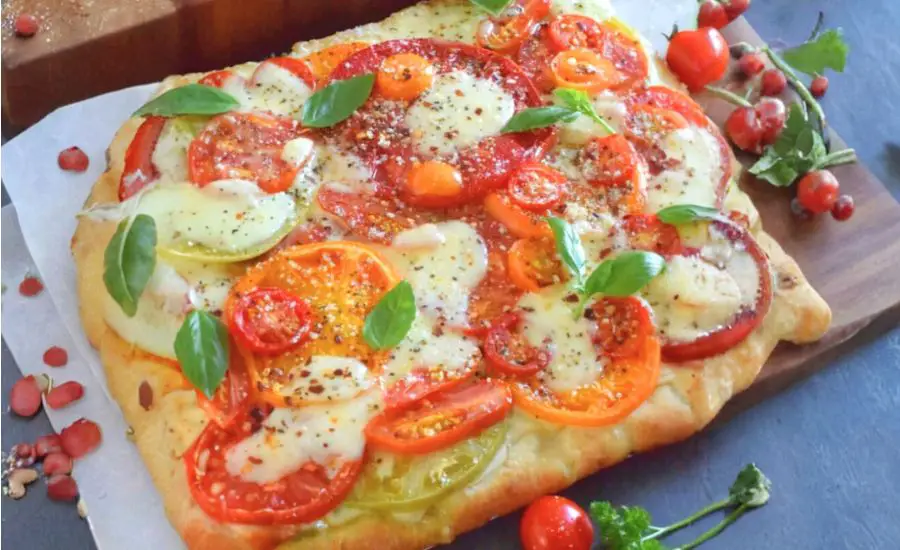All products are selected by our editorial team for quality. If you buy through our links, we may earn a small commission at no extra cost to you.
This Basil Pesto Tomato Flatbread is a vibrant, flavor-packed twist on traditional flatbreads that makes any meal feel special.
The combination of fresh heirloom tomatoes, creamy bocconcini, and a fragrant double-parmesan basil pesto delivers a perfect balance of savory, herbaceous, and slightly nutty flavors.
Beyond its taste appeal, this recipe offers notable health benefits: it’s fiber-rich from fresh tomatoes, provides plant-based protein through cheese and nuts, and contains heart-healthy fats from olive oil and pine nuts.
With minimal added sugar and moderate calories, it’s a nourishing choice for lunch, dinner, or snack time.
Quick to prepare and baked in just 10 minutes, this flatbread is ideal for everyday cooking, weeknight meals, or easy entertaining.

Its visually stunning presentation makes it both satisfying to eat and a feast for the eyes.
Must-Have Tools for Perfect Results
Mixing Bowl
Essential for combining and proofing the yeast dough. A large, heat-tolerant bowl ensures even yeast activation and smooth dough formation. Its versatility extends to whisking, marinating, and tossing salads.
Food Processor
Perfect for creating smooth, evenly blended basil pesto. A quality processor reduces prep time and can handle everything from chopping nuts to pureeing sauces, making it a kitchen workhorse.
Rolling Pin
Ensures the flatbread dough is evenly shaped for uniform cooking. Beyond this recipe, a rolling pin is invaluable for pastries, cookies, and pizza dough.
Skillet
Ideal for toasting pine nuts without burning. A sturdy skillet distributes heat evenly and doubles for sautéing vegetables, searing meats, or making quick sauces.
Baking Sheet
Provides a flat surface for baking the flatbread to a crisp golden finish. Non-stick or lightly greased sheets are also perfect for roasting vegetables or baking cookies.

Healthy Basil Pesto Tomato Flatbread
Equipment
- 1 large mixing bowl
- 1 Food processor
- 1 Rolling Pin
- 1 Skillet
- 2 Baking Sheets
Ingredients
For the Flatbread Dough:
- ¾ cup warm water 110°F
- 1 teaspoon active dry yeast
- 1 ½ tablespoons olive oil
- 1 teaspoon sugar
- 2 ¼ cups all-purpose flour
- ½ teaspoon salt
For the Basil Pesto:
- 2 cups fresh basil leaves
- ½ cup parmesan cheese
- 1 clove garlic
- 1 tablespoon lemon juice
- ¼ cup pine nuts toasted
- ¼ cup olive oil
- ½ teaspoon ground black pepper
- ½ teaspoon dried red chili flakes optional
Toppings:
- 2 large heirloom tomatoes sliced
- 1 large green tomato sliced
- 1 large beefsteak tomato sliced
- 1 cup grape or cherry tomatoes halved
- 200 grams mini bocconcini
- Fresh basil leaves for garnish
- Olive oil drizzle optional
- Fresh parmesan optional
Instructions
- Activate the Yeast: Begin by preparing your yeast for the flatbread dough. Warm 3/4 cup of water to about 110°F — it should feel comfortably warm to the touch, not hot. Pour this water into a large mixing bowl and sprinkle in 1 teaspoon of sugar. Add 1 teaspoon of active dry yeast on top and allow it to sit for 2–3 minutes. You should notice the yeast starting to bubble and foam slightly, which signals that it’s active and ready.This step is crucial for creating a light, airy flatbread.
- Incorporate Olive Oil: Once the yeast is activated, whisk in 1 1/2 tablespoons of olive oil. This enriches the dough, giving it a tender texture and subtle flavor. The olive oil also helps prevent the dough from sticking during kneading, making it easier to work with.
- Mix and Knead Dough: Add 2 1/4 cups of all-purpose flour and 1/2 teaspoon of salt into the bowl with the yeast mixture. Using a wooden spoon or your hands, begin to mix the flour into the liquid gradually. Once the ingredients come together, knead the dough for about 8–10 minutes until it becomes smooth, elastic, and slightly tacky to the touch. Proper kneading ensures that gluten develops evenly, giving the flatbread structure and chewiness.
- Proof the Dough: Cover the kneaded dough with a clean kitchen towel and place it in a warm, draft-free area to rise. Let it rest for 30–45 minutes or until it doubles in size. Avoid placing it near an open window or in a cold draft, as yeast activity is sensitive to temperature changes. This resting period allows the dough to become light and airy.
- Toast the Pine Nuts: While the dough is rising, place 1/4 cup of pine nuts in a dry skillet over medium heat. Shake the skillet frequently to keep the nuts moving and prevent burning. Once they turn golden brown and release a warm, nutty aroma, remove them immediately onto a plate to cool. Toasted pine nuts deepen the flavor of your pesto and add a pleasant crunch.
- Prepare the Basil Pesto: In a food processor, combine 2 cups of fresh basil leaves, 1 clove of garlic, 1 tablespoon of lemon juice, and 1/4 cup olive oil. Pulse until the basil is finely blended and smooth. Add the cooled toasted pine nuts, 1/2 cup parmesan cheese, 1/2 teaspoon black pepper, and 1/2 teaspoon red chili flakes (if using). Pulse 3–4 times to incorporate, leaving small specks of nuts and cheese for texture. Set the pesto aside while you shape the flatbread.
- Preheat Oven and Prepare Pan: Preheat your oven to 500°F (260°C) to ensure a crisp, golden crust. Lightly spray or line a baking sheet with non-stick spray. This prevents sticking and allows the flatbread to cook evenly. Using a high temperature ensures a quick bake, keeping the toppings fresh and flavorful.
- Shape the Flatbread: Divide the risen dough in half. On a lightly floured surface, roll one portion into an oblong or rectangular shape that fits your baking sheet. A rolling pin ensures even thickness, which helps the flatbread bake uniformly. Repeat with the second portion of dough.
- Spread the Basil Pesto: Generously spread half of the prepared basil pesto over each flatbread, leaving about a 1/2-inch border around the edges. This layer of pesto serves as the flavor foundation, adding herbaceous richness and a creamy, nutty taste that complements the tomatoes.
- Add Tomato and Cheese Toppings: Arrange sliced heirloom, green, and beefsteak tomatoes on top of the pesto. Scatter grape or cherry tomatoes for color and sweetness. Tuck 200 grams of mini bocconcini evenly across the surface. Sprinkle lightly with ground black pepper to enhance flavor. This combination creates a colorful, nutrient-rich topping loaded with fiber, vitamins, and plant-based protein.
- Bake to Perfection: Place the prepared flatbreads in the preheated oven and bake for 10 minutes or until the crust is golden and the cheese is slightly melted. Keep an eye on the oven to prevent over-browning. The high heat ensures a crisp exterior while maintaining a soft, tender interior.
- Garnish and Serve: Remove the flatbreads from the oven and immediately top with fresh basil leaves, a drizzle of olive oil, and optional freshly grated parmesan. Slice into portions and serve warm. The vibrant colors, fragrant basil, and creamy cheese make this dish both visually stunning and irresistible to the taste buds.
Notes
- Use fresh, ripe tomatoes for the best flavor and texture.
- Toast pine nuts gently to avoid bitterness.
- Keep the dough in a warm, draft-free spot to rise properly.
- Don’t over-pulse pesto; small bits of nuts and cheese give texture.
- High oven heat ensures a crisp crust and melty cheese.
- Bocconcini can be swapped with mozzarella pearls if unavailable.
- Allow flatbread to cool slightly before slicing to prevent toppings from sliding.
- Optional: add a pinch of red chili flakes for subtle heat.
Chef’s Secrets for Maximum Flavor
The secret to an unforgettable flatbread lies in balancing freshness and technique.
Gently toasting pine nuts before blending releases their natural oils and nutty aroma, which intensifies the basil pesto’s depth.
Using multiple tomato varieties not only enhances color but also delivers a mix of sweet, tangy, and juicy flavors.
Kneading the dough properly and allowing it to rise in a warm, draft-free environment ensures a tender yet slightly chewy flatbread that holds the toppings perfectly.
Finally, spreading pesto generously but leaving a small border allows the crust to crisp without losing moisture.
Simple attention to these details elevates the flatbread from ordinary to restaurant-quality.
Serving Suggestions for Every Occasion
This flatbread shines as a light lunch, appetizer, or casual dinner.
Serve it alongside a crisp green salad for a refreshing contrast, or pair with a chilled white wine to complement the basil’s herbaceous notes.
For a heartier meal, add slices of grilled chicken or roasted vegetables on top.
It also works beautifully as part of a brunch spread or as finger food for gatherings.
Warm slightly before serving if previously refrigerated, and drizzle with extra olive oil or balsamic glaze for added flair.
Storage Tips for Best Freshness
Store leftover flatbread in an airtight container in the refrigerator for up to 3 days.
To maintain a crisp crust, reheat in a preheated oven at 350°F for 5–7 minutes rather than using a microwave.
The pesto will remain vibrant if stored in a small jar or airtight container for up to 5 days in the fridge.
For longer-term storage, dough can be prepared in advance and frozen, ready to be rolled and baked whenever you need a quick, flavorful meal.
Frequently Asked Questions About Flatbread
1. Can I make the dough ahead of time?
Yes! Dough can be prepared, covered, and refrigerated for up to 24 hours before rolling. Bring it to room temperature for 15–20 minutes before shaping.
2. What is the best cheese to use?
Mini bocconcini or mozzarella pearls work beautifully, providing creaminess without overpowering the tomatoes. Parmesan adds umami and depth to the pesto.
3. Can I substitute nuts in the pesto?
Absolutely! Walnuts, almonds, or cashews can replace pine nuts for a slightly different flavor profile while keeping the healthy fats intact.
4. How do I make the flatbread crispier?
Roll the dough slightly thinner and bake on a preheated, lightly greased baking sheet at high heat (500°F). Avoid overcrowding the oven for even cooking.
5. Can I make this recipe gluten-free?
Yes, using a gluten-free all-purpose flour blend works. You may need to adjust water amounts slightly for proper dough consistency.
This recipe is inspired by lordbyronskitchen and has been carefully refined to enhance clarity, streamline preparation steps, and ensure accurate results. We’ve also included health benefits, nutritional highlights, and Must-Have Tools to help you get the best results every time you cook.

